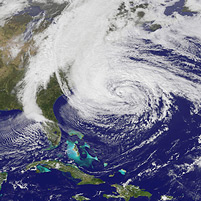After Sandy


Event organizer and CMU alumnus Marrick Smith
From fundraising to technology solutions, the Carnegie Mellon University community pulls together to help those impacted by natural disasters.
Specifically for victims of Hurricane Sandy, a Nov. 13 concert in New York will feature CMU theater talent.
Corey Cott (A'12), Zak Resnick (A'09), Hunter Ryan Herdlicka (A'09), Lora Lee Gayer (A'09), Kara Lindsay (A'07), Tess Soltau (A'10), and Jessica Waxman (A'08) will be among the artists featured on the Laurie Beechman Theater stage.
The event was organized by actor, writer, CMU alumnus and Staten Island native Marrick Smith (A'12). After working hard to rebuild his neighborhood and volunteer in shelters since the storm hit, he was inspired to coordinate this event to help raise funds for the victims in his community.
Meanwhile, CMU researchers on the West Coast are preparing for similar disasters by developing new communications tools.
"As voice and data networks have become more complex, they have also become more vulnerable in the face of natural disasters like hurricanes and earthquakes," said Bob Iannucci, director of the CyLab Mobility Research Center and a distinguished service professor at Carnegie Mellon University in Silicon Valley.
"And while police, fire and other emergency responders have their dedicated communication tools, impacted community members may find themselves without the ability to access Internet services, social networks and other popular means of communication."
Iannucci leads a team of CMU researchers dedicated to helping community members help themselves to stay in touch via a new project called the Survivable Social Network (SSN).
The SSN is one of several ongoing research projects as part of CMU's Disaster Management Initiative (DMI).
In partnership with the city of Palo Alto, Iannucci and his team are developing a system that can be deployed in and by a neighborhood to provide resilient social networking tools accessible via smart phones without dependence on public telecommunications infrastructures.
"SSN offers the promise of a familiar-feeling, easily-used, trainingless system for the sharing of vital information in the midst of a disaster," said Iannucci.
He demonstrated the SSN system Nov. 4–5 at the Third Annual DMI Workshop called "Making Smart Communities Resilient" at Carnegie Mellon Silicon Valley.
"When fully developed, tools like SSN could help provide essential communication capabilities for impacted communities as an important part of an overall recovery effort," Iannucci said.
The Federal Communications Commission (FCC) reported that the number of cellphone tower outages dropped the second day after Sandy slammed the East Coast, with just a fifth of the sites offline by Wednesday.
"While there is no substitute for full restoration of services, we feel that SSN's ability to let neighbors connect to neighbors and to locate authorities during recovery will be beneficial. SSN does this by taking advantage of the considerable capabilities of widely-used, low-cost, off-the-shelf smartphone and computer technology," Iannucci said.
Related Links: Read more | Disaster Management Initiative | Survivable Social Networks | Carnegie Mellon in Silicon Valley | Details for Benefit Concert
